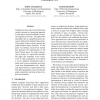163 search results - page 20 / 33 » Use of Lexicon Density in Evaluating Word Recognizers |
PRL
2007
13 years 7 months ago
2007
This paper introduces a novel method of visual learning based on Genetic Programming, which evolves a population of individuals (image analysis programs) that process attributed v...
EUROGP
2010
Springer
14 years 25 days ago
2010
Springer
We describe a data mining framework that derives panelist information from sparse flavour survey data. One component of the framework executes genetic programming ensemble based s...
NAACL
2007
13 years 9 months ago
2007
Graph-based semi-supervised learning has recently emerged as a promising approach to data-sparse learning problems in natural language processing. All graph-based algorithms rely ...
ASPLOS
1989
ACM
13 years 11 months ago
1989
ACM
A very long instruction word (VLIW) processorexploits parallelism by controlling multiple operations in a single instruction word. This paper describes the architecture and compil...
EMNLP
2008
13 years 9 months ago
2008
Human linguistic annotation is crucial for many natural language processing tasks but can be expensive and time-consuming. We explore the use of Amazon's Mechanical Turk syst...

